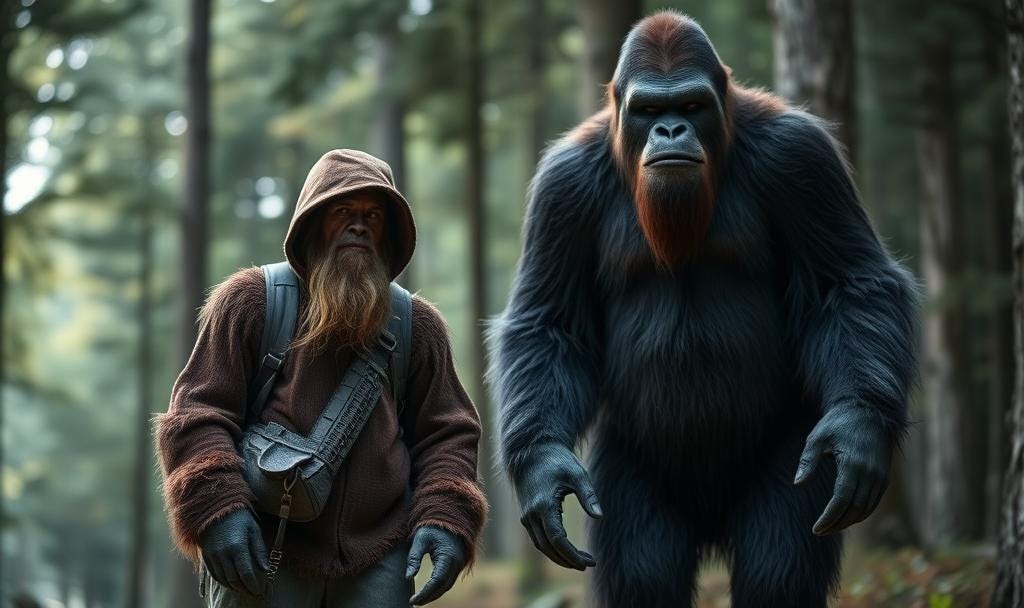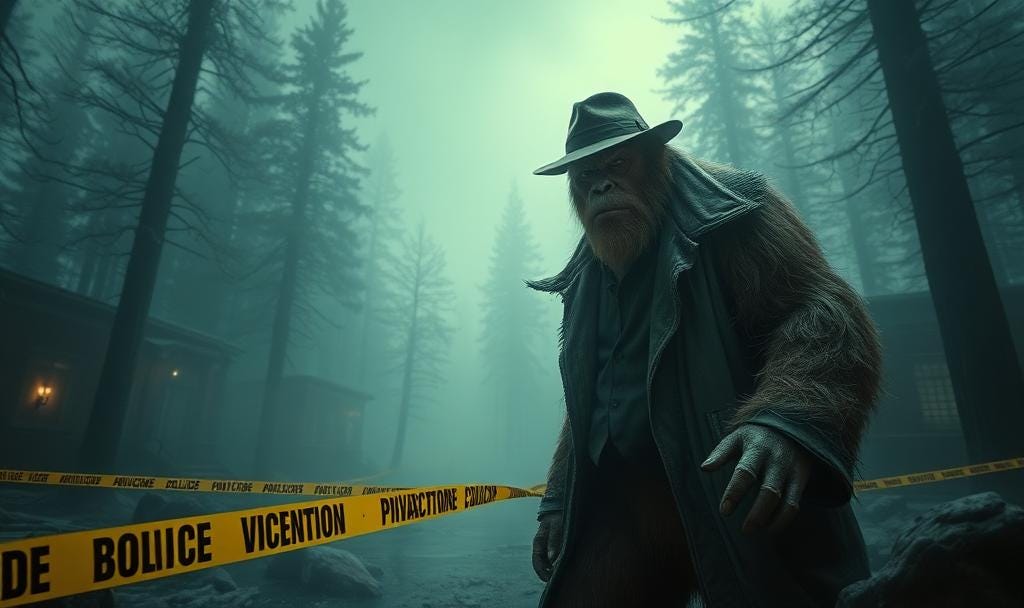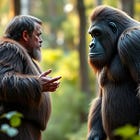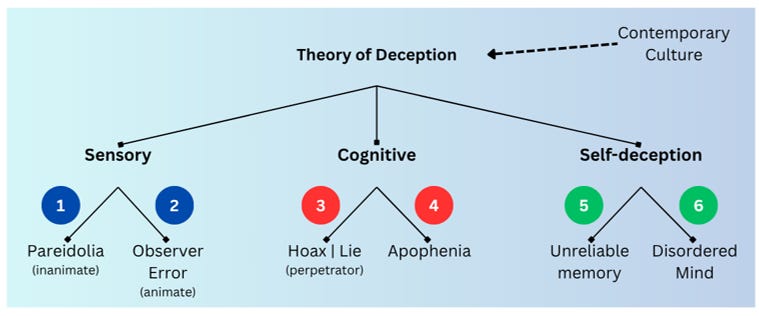We're Gonna Need a Search Warrant
Can we explain Bigfoot encounter reports as something other than Bigfoot?
Before I took a two-post tangent into artificial intelligence, I shared my initial assessment of the Bigfoot Field Research Organization’s (BFRO) witness encounter reports dataset. After filtering the dataset based on encounter location and year, I had 1,013 reports to explore. BFRO investigators had coded most of them —63% — as Class B, which signals an absence of visual confirmation of the creature during the encounter.
In addition to these BFRO classifications, I coded a subset of the 1,013 reports into what will soon be officially called “The TSB Levels of Interaction” or simply “TSB levels”. OK. Now it’s official. These range from Level-0 through Level-4, with higher levels *generally* indicating more extensive interaction between the witness and the Bigfoot. Read more about the TSB levels in an earlier post.
I hear my wife moving around upstairs right now. I know it’s her but I don’t have visual confirmation. That’s Class B. It’s also a Level-1. Now, if she comes downstairs into my line of sight, then that’s a Class A. It’s also, incidentally, a Level-2 interaction. But as soon as she sets eyes on me, we jump to Level-3: mutual recognition. Things are getting more intense. Let’s say I have a roast beef sandwich. My wife comes over and reaches for half of it. Bam! Level-4: competition for resources.
The BFRO classifications and the TSB levels show moderate correlation (r = .53, n = 113). This basically means that Class A reports are more likely than Class B reports to come at higher TSB levels1.
These metrics are interesting and somewhat helpful. I could argue hundreds of BFRO Class A reports cannot all be wrong, but debunkers would disagree and contend that witness reports are unreliable and prove nothing scientifically.
Let’s leave the “scientifically” to the scientists. I just want to get myself off the metaphorical Bigfoot fence. To do this, I can go back to the Theories on Bigfoot post, collect a list of alternative explanations, and see how these witness reports hold up.
Theories on Bigfoot: Recap
Two months ago, I summarized the various theories about Bigfoot that I had covered between February and April this year. This involved a lot of different theories and hypotheses, but I had to get them out of my head. Eventually, I landed on two main theories: Bigfoot are a Real Species and Bigfoot are rooted in Deception. The idea that Bigfoot are either A or B is nothing new, though my organization of alternative arguments as Deception seemed new, at least in the Bigfoot space. The closest idea came from David Daegling with his term “Human Agency”2, though I found this to be misleading. Anyway, here’s my post from 2 months ago.
If you’re feeling adventurous and you have 10 minutes to spare, maybe go back and read that post. You don’t really need to, though. My focus right now is on Deception and the main arguments that fall within that theory. And there are several.
Proving Bigfoot are a real species is difficult without a physical body. I don’t think DNA from blood or hair would even be enough. Witness reports definitely won’t. But we can build support for the Real Species theory. We can do this by rejecting the arguments within the theory of Deception. If none of these arguments fit, then the witness report is best explained by the Real Species theory, at least until a better explanation comes along. Essentially this is Occam’s razor — the simplest explanation is the most likely one, after all other possible explanations have been rejected.
Main Arguments from the Deception Theory
Here’s a colorful visual of the theory of Deception and its main arguments. If you read my Breakdown post this might look a little different. Theories can evolve, and I’m not quite done with this one. The main difference from the earlier version (May 1, 2025) is that I moved apophenia from Self-deception to Cognitive deception. Honestly, it could fit in either place, but this move created a balanced diagram. I guess I share that appetite with Thanos3.
Arguments under Sensory deception (blue dots) relate to how we take in and interpret information about the environment through our senses — for our purposes these are mainly sight, hearing, and smell. Cognitive deceptions (red dots) are about affecting how others, or how we ourselves, perceive reality. Self-deceptions have more to with how our brains organize and reconstruct information. If you’re not confused yet, here are more explicit definitions of each argument within these three main categories.
Sensory- Pareidolia: seeing inanimate objects as something other than what they are. For example, seeing a tree stump but believing it’s a Bigfoot.
Sensory- Observer error: more commonly referred as misidentification of one living thing for another. For example, seeing a bear but believing it’s a Bigfoot.
Cognitive- Hoax or lie: a deliberate effort to trick someone into believing something that is untrue. For example, generating a dataset of fictional Bigfoot reports and then claiming they represent real encounters.
Cognitive- Apophenia: our tendency to perceive meaningful patterns or connections in random or unrelated information. For example, hearing twigs snapping and animal howls and believing they are both caused by a Bigfoot.
Self-deception- Unreliable memory: the confounding of prior experiences with new and unrelated information to form inaccurate memories. For example, seeing a bear while hunting and then watching a documentary on Bigfoot and then remembering seeing a Bigfoot while hunting.
Self-deception- Disordered mind: the difficulty separating reality from fantasy or hallucination… For example, eating mushrooms while camping and believing your camp is surrounded by rainbow Bigfoot.
Each of these arguments is full of nuance and is difficult to represent in a few sentences. In fact, there’s a sizable literature base for each one. Overcoming these six arguments is a lot for a Bigfoot encounter report. My hope is that any Bigfoot investigator would gather enough evidence when doing fieldwork to reject these forms of deception.
But if the debunkers are correct, most or all BFRO reports could be explained by one or more of these six arguments. Let’s see if they’re right.
Armchair Researching
By no means do I intend to prove or disprove the existence of Bigfoot. I want to learn more about witness reports and what they can tell us; specifically, whether they support one theory more than the other.
Here’s my plan: I’m going to review several cases — maybe 30 or so — over the next few weeks and see how many I can explain using the Deception arguments. I plan to focus on Class A reports — those reports that the BFRO considers good evidence — and among the Class A reports those that I coded as Level-2 or higher. If I’m going to find support for Bigfoot as a real species, these cases should increase my odds of finding it.
While I won’t be doing any fieldwork, I do have access to BFRO case information. First, I have the witness’s written description of the encounter. This is critical but we know from previous posts that witnesses vary on details. Some witnesses are terse while others ramble. Of course, a lot could be said in a few words, but in general more words give me more information about the encounter.
The BFRO also offers the investigator’s report. Remember that the BFRO investigates every encounter before posting it on their website. This involves in many cases an in-person interview and a scouting of the area in which the encounter occurred. I know little about the investigation process or its protocols, though I suspect I’ll have a good sense of this after reviewing a few reports.
Finally, there are several data points tied to each encounter, such as the location, date and time, weather conditions, and other factors. These could come in handy. I’ll just have to see if they prove useful.
A Trial Run on a Real BFRO Case

Here’s a quick test case. This is BFRO case # 585344. I pulled this one for its brevity and before I reviewed the investigator’s report. Here’s how the witness described the encounter:
I went into my woods, I was sitting at my deer spot and after sitting for about an hour a few deer ran through the woods. They acted as if something was pushing them. A few seconds later, a Sasquatch (7.5-8 foot tall, reddish brown hair) came following them.
— BFRO case # 58534
On reading only the witness’s description it’s easy to dismiss this as a hoax or lie: a Cognitive deception. It’s the standard hunter-sees-Bigfoot narrative: I was in my deer stand. Deer ran past me. A Bigfoot followed. It was 8 feet tall. It wasn’t a bear. I swear I have this one in my dataset of fictional Bigfoot reports! But let’s keep going with it. Some witnesses just don’t rattle on as I tend to do.
The encounter happened in November 2017 in Pennsylvania. The BFRO investigator labeled this as Class A and I coded this as a Level-2 with the possibility of a Level-3 interaction. On its own, the witness’s description lacks critical information, such as the duration and general observability of the encounter. Let’s see what the investigator’s report can tell me. The link to the report is in the footnotes.
Hmm… the investigator’s report does not include anything that could help me reject a sensory deception argument. There’s no information on the sighting distance, the witness’s eyesight, the height of the tree stand, the use of a scope or binoculars, the amount of daylight, or the duration of the encounter. Without these details we must keep the observer error argument on the table. The investigator’s report did, however, highlight unusual activity in the area. Here’s what he gathered from the witness:
He told me additional stories from the surrounding area. Most of the family has had some sort of unexplained activity, howls, knocks and whoops. They even had 45 chickens that through the years were all taken or killed. He told me some were taken by an owl but most were not. They had ducks that were killed and left in the enclosure, the heads were pulled off the ducks and left in a pile.
That’s unfortunate for the ducks. Gruesome, really. That’s some Blair Witch Project shit right there. The investigator felt the witness to be “a sincere person that did nothing to lead me to think of a hoax.” I’m inclined to accept this, but there’s still the second Cognitive deception argument: apophenia. This argument would say the witness’s awareness of unusual activity in the area led him to see a pattern that could only be explained by Bigfoot. Combined with possible conditions for observer error, it’s plausible the witness did not see a Bigfoot as he claimed.
God, I sound like a debunker!

Bottom-line
I may sound like a debunker but I’m a skeptic acknowledging that this low observability + apophenia argument is a plausible explanation for what the witness reported. I’m not picking sides, I’m following the available data to a reasonable conclusion. It could have been a real Bigfoot or a form of deception. But based on the data on hand, the theory of Deception takes precedence until more details can be gathered from the witness.
Point goes to Deception on this one. I’ll keep reviewing cases over the next few weeks and spare you the details of this sometimes-tedious analysis. When I’m done, I’ll post my conclusions.
Next Time on TSB
I’ve been reading more about apophenia and contemplating its application to Bigfoot and other subjects. Spoiler alert: we’re all prone to this tendency to find patterns in random data. It’s just a matter of degree. I’m also curious about Bigfoot height estimates. Are all Bigfoot 7-8ft tall or is there something else at work here? There’s scientific research on how we form these judgements and understanding this process will help me interpret these BFRO reports. So next time it’ll be apophenia or height estimates. Stick around and find out. In the meantime, mind your synapses, troopers!
Thanks for reading and don’t be a Stranger,
DC | TSB
For the curious, I coded Class B as 0 and Class A as 1. TSB levels remained as 0 through 4. I used Kendall’s tau for correlation analysis.
This is from Daegling’s book, Bigfoot Exposed, 2004.
A reference to the antagonist in The Avengers trilogy.
BFRO Case # 58534 at https://www.bfro.net/GDB/show_report.asp?id=58534







